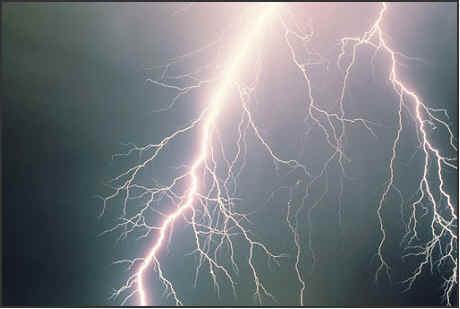Outdoor safety topic lightning
Source:- A Wednesday evening Forum held by Wally Drew, 1995, and updated June 1999.
Avoidance
- Have some knowledge about weather, especially mountain weather:
-
Highest risk areas:
- foothills and east side of the Rockies, especially to the north
-
Highest risk times:
- midday and afternoon in the Rockies
- afternoon in the foothills
- late afternoon and evening on the prairies
-
Lightning season:
- early May to mid September with July peak
-
Storm direction:
- in the Rockies generally from the west, southwest or south
- east of the Rockies the same, but also from the north and northwest
- Get all the forecast information you can:
- Calgary area forecast includes the foothills and the east slopes of the mountains but is site specific to the Calgary airport. Banff (mountain park) forecast is site specific for the town of Banff. We do not get forecasts for Yoho, Kootenay or Waterton Parks.
- Keep eyes and ears open on trips:
- Early indications of lightning:
- vertical cloud build-ups, especially when rapid
- very dark clouds approaching, sometimes green-black
- turbulence in clouds
- thunder: 3 seconds per km or 5 seconds per mile. (Distance can be vertical, horizontal, or a combination)
- Imminent indications for a lightning strike:
- lightning and thunder nearby
- gusts of cold wind
- large rain drops, hail, snow flakes, or graupel
- mammary appearance on the bottom of the cloud
- humming, buzzing, tingling, hair standing on end
- gun shot thunder sound
- Dangerous locations:
- tops of peaks and ridges especially above timberline - have an escape route
- beneath or beside a lone tree, a taller tree, or on the edge of a taller forest
- shallow caves or scoops in cliffs, in ditches, water or on a rope
- wooden huts or shelters in the open. Open structures aren't considered safe
Lightning doesn't always strike the highest object nearby. On average lightning will hit again 10-13 km from the last strike. The streak has an irregular path and selects a point to strike in the last 30m or so. The most severe part of a thunderstorm is along the fringes. Lightning can strike up to 16 km from the rain/hail shaft and can reach out from the anvil to strike beneath clear sky: the proverbial bolt from the blue. Lightning can penetrate up to 5m into the ground.
30/30 Rule:
When flash to bang count is down to 30 seconds (= 10 km) you should be in a safe
place and shouldn't leave it until 30 minutes after the last thunder is heard. (This
wait seems a little extreme, but you should wait at least 30 minutes after the last
nearby lightning strike.) Thunder is always caused by lightning.
If You Are Caught
- get off high points if you have time, the lower the better
- get into forest of uniform height, or into a metal structure (vehicle too), if time
- closed cars & buildings are safe but don't touch sides of the car or get close to electrical wiring, plumbing or metal stoves & chimneys
- do not touch trees, walls, or sides of deeper caves
- chuck large metal objects, un-rope, separate
- try to keep dry
- remember: ground currents are dangerous 10’s of meters from the strike
- squat (or kneel) down with feet (and knees) together with nothing else touching the ground
- when crouching cover ears with hands and tuck head down
- do this on the ground or a well conducting metallic base such as a bicycle
- sit on your pack (if dry, and greater than 10 cm or 4” thick) with feet together
First Aid
- treat for possible breathing problems, shock and or burns
- heart may stop and restart, breathing may cease: CPR can be successful
- there is no danger in touching the casualty
- there may be after effects, some permanent
- being hit by lightning side flash is fatal 20% of the time and ground currents 3% of the time
Above all take the threat of lighting very seriously. It presents the most dangerous hazard we are likely to encounter on our summer trips. Don’t be too proud to abort a trip even if only a few minutes from your goal.
